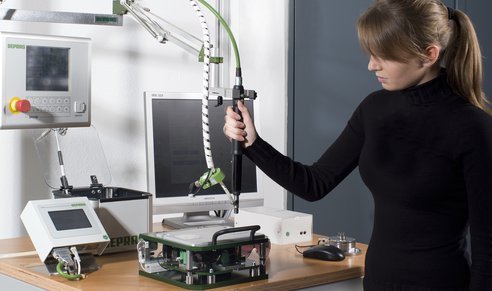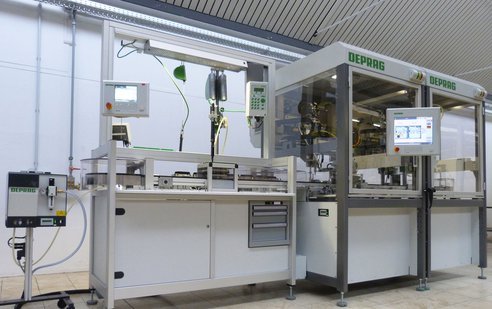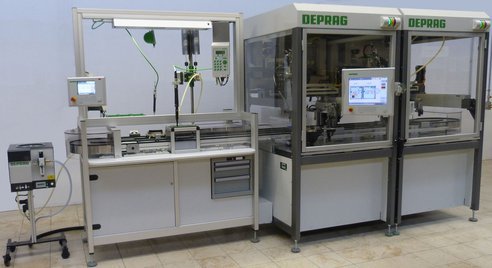Trixy Schmidt: Mr. Hierold, which aspect do you believe will be the main focus this year at MOTEK; where are the trends taking us?
Jürgen Hierold: The industry is showing clear signs of taking a fresh approach to assembly work - moving away from a rigid full automation process towards more flexible worker-guided semi-automated workstations.
Trixy Schmidt: Is there a reason for this trend?
Jürgen Hierold: There are several factors at play here, such as the high level of flexibility these solutions offer. During the financial crisis of 2008 many industries saw a fall in sales. Fully automated plants and machinery harbour intrinsic risks. A return on such investments can only be achieved if used to 100% capacity, and in economically difficult times financial investment collapses. On the other hand, if there is an unexpected rise in demand, a fully automated plant cannot operate at over-capacity. So, even if they want to, the production engineers cannot react appropriately to a fuller order book - 100% is the limit.
Trixy Schmidt: So what is the alternative?
Jürgen Hierold: Intelligent manual workstations can be flexibly adapted to suit any economic situation. In difficult times production can be cut back without harming business, and in good times there is no limit to expansion.
Trixy Schmidt: But what about process reliability? Worker-guided semi-automated machines are operated by humans, and humans sometimes make mistakes...
Jürgen Hierold: With an intelligent manual workstation, process-reliability assurance can be obtained just as for a fully automated assembly plant. But here we are at a very significant point. It is essential to consider very thoroughly how the manual workstation should be structured, and certain key requirements must be addressed without fail. Otherwise mistakes can be made at the planning stage which could cause problems later on. Here, our automation specialists follow special guidelines to ensure that all the essential issues are dealt with. Process reliability is the first aspect we look at when designing an intelligent manual workstation.
Trixy Schmidt: To achieve reliability at each step of a process it is necessary to be able to count on the repeatability of each step and on the parameters of the process remaining within certain specified tolerances. So how is this achieved in practice?
Jürgen Hierold: When we are equipping the intelligent manual workstation, the width of the tolerance window is what defines the level of quality for each component deployed. So we start by defining the process security that is required for the task in hand. There is a huge risk of misunderstandings arising here. We have to discuss in detail, and accurately document, the requirements and solutions for process security throughout the entire assembly process. Any error in the design concept, especially with this important aspect of process reliability, can be corrected at a later stage but only with difficulty and at a high cost.
Trixy Schmidt: What solution would be best for me if I have a very narrow tolerance range in my assembly task, and I have to meet very stringent quality requirements?
Jürgen Hierold: Electronic programmable screwdriving tools meet very high quality requirements in fastening technology. With these tools, you can analyse the screwdriving parameters, carry out the statistical calculations, and capture the production data (PDA). The tools can be incorporated into production management systems (PMS) and they can also record and archive the results of the assembly task in question. The high level of process reliability at each step of the assembly process is guaranteed by the components at the workstation since they have been designed specifically to meet these requirements. As with a jigsaw puzzle, all the components at the workstation have to fit together, and must interact and communicate with one another. Besides the high-quality reliable screwdriver systems, other parts of the puzzle include appropriate screw feeder systems, screw positioning systems ensuring impeccable operator control, screwdriver and sequence control systems complete with corresponding software, the part pick-up and positioning devices, to mention just a few examples.
Trixy Schmidt: To a large degree, modern manual workstations are meeting the call for more flexibility in production. What do you need to include in the process when you are planning the semi-automated manual workstation?
Jürgen Hierold: Flexibility can concern different parts of the process. So when we plan a workstation we first have to define precisely the type of flexibility that is required. Do you want flexibility in the process sequence? How often do you need to retool? How long is the product's service life? What will happen to the manual workstation once the product is no longer produced? Will production numbers need to be adjusted? Will it be necessary to assemble many product variants at one manual workstation? DEPRAG has an answer for each of these questions. It is important to ask the questions at the right time. The same principle applies: it is difficult and expensive to correct any mistakes later on. We have a range of standard solutions. An example: a screw feeder system linked to the workstation supplies several different types of screw to a single screwdriving tool. This is controlled accurately via a screw positioning portal. The portal detects the xy coordinates for the screw position and communicates with the feeder systems and the screwdriver control system to select the fastener required, along with its fastening parameters - precisely and accurately. Alternating pick-ups can be provided if the part pick-ups need to be variable.
Trixy Schmidt: A manual workstation represents the classic interconnection between man and machinery. Where consistently high quality is required in production the human element is the risk factor...
Jürgen Hierold: Only a manual workstation that incorporates the needs of the human right from the start can guarantee optimum production quality. Under our ergonomics theme our guidelines highlight a whole range of aspects that play a part in equipping a user-friendly workstation. We focus on accurate, reliable and non-fatiguing work, workplace safety, user-friendly reactions, and on the clear display and analysis of process data and errors, while also making it easy to correct any errors. Added to the mix is optimum materials flow - and this is very important - ergonomic designs of the screwdriver tools, for example. And the relevant HMI (human machine interface) with user-friendly hardware and easy-to-understand software, together with excellent visualisation of the processes all contribute to increasing the all-important acceptance by the machine operators of the working environment. Only people who enjoy their work will do it well.
Trixy Schmidt: High-quality and very sensitive electronic components are fitted in the manual workstations, such as electronic circuit boards. What is the situation regarding ESD capability and the technical cleanliness of operator-guided semi-automated assembly plants?
Jürgen Hierold: We also flag up these aspects in our guidelines. When assembled on an intelligent manual workstation electronic products are protected against electrostatic discharge by specific dissipation techniques. Our DEPRAG solutions do this consistently (on every component at the manual workstation), and measurable evidence is provided for the end buyer. The same care is taken with regard to technical cleanliness. Contaminating particles can severely damage delicate components. Such particles can occur when fasteners feed into the screwdriving tool, or during the fastening process itself. Non-vibrating feed systems, and systems to position and assemble the fasteners using vacuum suction, as well as particle traps throughout the production process all help to minimise the dangers posed by contaminating particles. The requirements for technical cleanliness and ESD capability must be implemented consistently for every single component on the system. So it is advantageous if all the component modules match.
Trixy Schmidt: DEPRAG happily describes itself as a One-Stop-Shop for every solution to equip assembly lines from a single source. Is that really an advantage? Or even economically beneficial?
Jürgen Hierold: Of course it is! It's clear to see. Customers have a single point of contact right from the start. For them that represents a huge reduction in effort and work. They are obtaining process and applications knowledge from a single source, and solutions based on many years of experience. So they are minimising their risks. Having a single centre of responsibility provides the customer with assurance that all the components of the system will be available, with their functionality confirmed over many years of experience, and that the project will be implemented quickly. With the use of standard components lead times are reduced; the rationalisation effects for the manufacturing process and the fact that complicated interface descriptions are not needed increase the economic viability of the new acquisition. DEPRAG covers the entire value-added chain.
Trixy Schmidt: You have opted for the intelligent manual workstation as being an economically viable and flexible alternative to fully automated assembly plant and machinery. Do you have an example you can give us?
Jürgen Hierold: DEPRAG has recently supplied an assembly line for power control devices used in an e mobility application - consisting of 40 manual workstations. At the present time the e mobility industry is uncertain of how production rates will develop. So the recommendation was to create a flexible, expandable assembly line with intelligent manual workstations. We obtained the order because, as a full service provider, we were able to implement all the technical requirements within a short time. Taking all the above criteria for an operator-guided semi-automated assembly line as a basis, it was possible to meet them all perfectly with DEPRAG standard components: process reliability, flexibility, ergonomics, ESD-capability, technical cleanliness and economic viability. For MOTEK 2013 DEPRAG has built a modern manual workstation on its stand. It will be demonstrating all the technical and economic options available for modern assembly processes.






